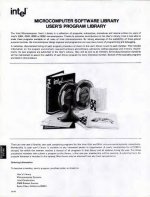In researching the history of Intel's Intellec series (8, 8/80, 800, etc) I've come across references to a library of routines that Intel made available to users for an annual subscription of $100.
Here are screenshots of two pages that give hints about the scope of the library:
1976 Intel Data Catalog page 10-46 (on bitsavers)

1979 inSite Program Library Volume 1 (also on bitsavers)

It doesn't appear that any of the material from Intel's collection is available through repositories such as bitsavers, archive.org and other sites. Note: I'm not referring to the ISIS-II software that Intel issued on floppy, much of which is available.
Does anyone have any of the 8080 material, whether on paper tape, floppy or as listings? I'm particularly interested in locating programs for the Intellec 8/Mod80 and MDS-800.
Documentation of the software would also be of great value.
Here are screenshots of two pages that give hints about the scope of the library:
1976 Intel Data Catalog page 10-46 (on bitsavers)

1979 inSite Program Library Volume 1 (also on bitsavers)

It doesn't appear that any of the material from Intel's collection is available through repositories such as bitsavers, archive.org and other sites. Note: I'm not referring to the ISIS-II software that Intel issued on floppy, much of which is available.
Does anyone have any of the 8080 material, whether on paper tape, floppy or as listings? I'm particularly interested in locating programs for the Intellec 8/Mod80 and MDS-800.
Documentation of the software would also be of great value.
